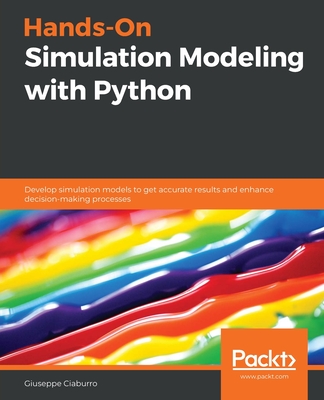A Student's Guide to Python for Physical Modeling, 2/e (Paperback)
暫譯: 物理建模的 Python 學生指南,第二版 (平裝本)
Kinder, Jesse M., Nelson, Philip
- 出版商: Princeton University
- 出版日期: 2021-08-03
- 售價: $1,540
- 貴賓價: 9.5 折 $1,463
- 語言: 英文
- 頁數: 240
- 裝訂: Quality Paper - also called trade paper
- ISBN: 0691223653
- ISBN-13: 9780691223650
-
相關分類:
Python、程式語言
-
其他版本:
A Student's Guide to Python for Physical Modeling: Second Edition
無法訂購
買這商品的人也買了...
-
 Thermal Physics, 2/e (Hardcover)
Thermal Physics, 2/e (Hardcover)$700$665 -
 $1,007Data Structures and Algorithm Analysis in Java, 3/e (IE-Paperback)
$1,007Data Structures and Algorithm Analysis in Java, 3/e (IE-Paperback) -
 程序員的數學3 : 線性代數
程序員的數學3 : 線性代數$474$450 -
 $607Python 學習手冊, 4/e (Learning Python: Powerful Object-Oriented Programming, 4/e)
$607Python 學習手冊, 4/e (Learning Python: Powerful Object-Oriented Programming, 4/e) -
 Group Theory in a Nutshell for Physicists (Hardcover)
Group Theory in a Nutshell for Physicists (Hardcover)$1,580$1,548 -
 $1,617Deep Learning (Hardcover)
$1,617Deep Learning (Hardcover) -
 程序員的數學2 : 概率統計
程序員的數學2 : 概率統計$474$450 -
 程序員的數學
程序員的數學$294$279 -
 $1,501The Linux Command Line : A Complete Introduction, 2/e (Paperback)
$1,501The Linux Command Line : A Complete Introduction, 2/e (Paperback) -
 Data Visualization with Python: Your guide to understanding your data
Data Visualization with Python: Your guide to understanding your data$1,200$1,140 -
 Deep learning 深度學習必讀 - Keras 大神帶你用 Python 實作 (Deep Learning with Python)
Deep learning 深度學習必讀 - Keras 大神帶你用 Python 實作 (Deep Learning with Python)$1,000$790 -
 Python 技術者們 - 練功!老手帶路教你精通正宗 Python 程式 (The Quick Python Book, 3/e)
Python 技術者們 - 練功!老手帶路教你精通正宗 Python 程式 (The Quick Python Book, 3/e)$780$616 -
 機器學習開發神器!Google Cloud Platform 雲端開發應用超入門
機器學習開發神器!Google Cloud Platform 雲端開發應用超入門$490$387 -
 $1,440Learn Quantum Computing with Python and IBM Quantum Experience
$1,440Learn Quantum Computing with Python and IBM Quantum Experience -
 $2,520Python for Data Analysis: Data Wrangling with pandas, NumPy, and Jupyter, 3/e (Paperback)
$2,520Python for Data Analysis: Data Wrangling with pandas, NumPy, and Jupyter, 3/e (Paperback) -
 電磁場數值計算及基於 FreeFEM 的編程實現
電磁場數值計算及基於 FreeFEM 的編程實現$474$450 -
 MATLAB 電磁場與微波技術模擬, 2/e
MATLAB 電磁場與微波技術模擬, 2/e$534$507 -
 電磁場與電磁波, 4/e
電磁場與電磁波, 4/e$414$393 -
 電磁波:在各向同性介質中的傳導
電磁波:在各向同性介質中的傳導$390$382
商品描述
A fully updated tutorial on the basics of the Python programming language for science students
Python is a computer programming language that has gained popularity throughout the sciences. This fully updated second edition of A Student's Guide to Python for Physical Modeling aims to help you, the student, teach yourself enough of the Python programming language to get started with physical modeling. You will learn how to install an open-source Python programming environment and use it to accomplish many common scientific computing tasks: importing, exporting, and visualizing data; numerical analysis; and simulation. No prior programming experience is assumed.
This guide introduces a wide range of useful tools, including:
- Basic Python programming and scripting
- Numerical arrays
- Two- and three-dimensional graphics
- Animation
- Monte Carlo simulations
- Numerical methods, including solving ordinary differential equations
- Image processing
Numerous code samples and exercises--with solutions--illustrate new ideas as they are introduced. This guide also includes supplemental online resources: code samples, data sets, tutorials, and more. This edition includes new material on symbolic calculations with SymPy, an introduction to Python libraries for data science and machine learning (pandas and sklearn), and a primer on Python classes and object-oriented programming. A new appendix also introduces command line tools and version control with Git.
商品描述(中文翻譯)
針對科學學生的 Python 程式語言基礎全新更新教程
Python 是一種在科學領域中廣受歡迎的電腦程式語言。本書《A Student's Guide to Python for Physical Modeling》的第二版經過全面更新,旨在幫助你,作為學生,自學足夠的 Python 程式語言,以便開始進行物理建模。你將學會如何安裝開源的 Python 程式環境,並利用它來完成許多常見的科學計算任務:數據的導入、導出和可視化;數值分析;以及模擬。無需具備先前的程式設計經驗。
本指南介紹了多種有用的工具,包括:
- 基本的 Python 程式設計和腳本編寫
- 數值陣列
- 二維和三維圖形
- 動畫
- 蒙地卡羅模擬
- 數值方法,包括解常微分方程
- 影像處理
大量的程式碼範例和練習題(附解答)在新概念介紹時進行說明。本指南還包括補充的線上資源:程式碼範例、數據集、教程等。本版新增了有關使用 SymPy 進行符號計算的材料,介紹了用於數據科學和機器學習的 Python 函式庫(pandas 和 sklearn),以及 Python 類和物件導向程式設計的入門知識。新的附錄還介紹了命令行工具和使用 Git 進行版本控制的內容。
作者簡介
Jesse M. Kinder is associate professor of physics at the Oregon Institute of Technology. Philip Nelson is professor of physics at the University of Pennsylvania. His books include From Photon to Neuron (Princeton), Physical Models of Living Systems, and Biological Physics
作者簡介(中文翻譯)
Jesse M. Kinder 是俄勒岡科技學院的物理學副教授。Philip Nelson 是賓夕法尼亞大學的物理學教授。他的著作包括《從光子到神經元》(Princeton)、《生命系統的物理模型》和《生物物理學》。





















